|
This review page is supported in part by the sponsor whose ad is displayed above
|
|||||||||||||||||||||
 |
|||||||||||||||||||||
| At some point, I had removed some of the batting we used for internal damping to see if the bass frequencies would increase in amplitude or extension but things were still a no go. We experimented with our Dial-A-Hole® system, too. Not the solution. Disillusioned, all we could do was look at each other and proclaim it a Salmon Day. You know how it goes. You spend an enormous amount of energy swimming upstream only to get screwed and die. Long story short, we either had some bad drivers or the fuck-up fairy had paid another visit. I'll let Pete take it from here. This is his email to the BBBA. |
|||||||||||||||||||||
 |
|||||||||||||||||||||
| July 30. Dear Audio Friends, | |||||||||||||||||||||
| this note is about Stephæn and Pete's Great Plains Audio 604 speaker project. Sixteen-inch 604 duplex drivers mounted in bottom-vented enclosures of approximately 10 cubic feet volume (actually turned out about 9 cubic feet after braces and speaker displaced volume). The drivers are the current heirs to a 604 speaker legacy spanning over 60 years. Predecessors of this driver have graced the listening rooms of many a mastering laboratory. Talk has it that this is the best 604 ever. This project is strongly influenced by Jay Fisher's 604 enclosure design, the primary difference being cabinet construction details to reduce weight. Hats off to Jay. Thank you Jay. |
|||||||||||||||||||||
| Hats off also to Bill Hanuschak of Great Plains Audio. No 604 drivers, no project. The drivers are the heart of the project. Our first playing of these speakers was pretty much a non-event, leaving everyone asking, "Where's the bass?" Apologies to Wendy's® burgers. A disappointment to Stephæn and Pete who labored hard in hot weather to construct the enclosures and crossovers and mount the drivers. Turns out the crossover assembly technician who wishes but will be unable to remain nameless, incorrectly connected the first choke in the tweeter branch of the crossover sending all low frequency energy to ground. The bottom line is that sonic impressions from the first weekend with the 604 speakers (Stephæn, we need to name these behemoths) have no connection to reality and are best expunged from memory. After reconfiguring the crossovers. we have wonderful speakers with clean, rich, deep, uniform, well integrated bass extending into the mid thirties. We also have inner detail and layering that is pretty much in a class by itself, excellent spatial presentation, unbelievably fast dynamics and wonderful musicality that draws the listener in for hours on end. Also, the Dial-A-Hole® adjustable vent works great. I guess in summary Stephæn was right - you can't keep a good driver down. He is in charge of auditions. Be prepared to pay admission. |
|||||||||||||||||||||
 |
|||||||||||||||||||||
| What follows is a (long) summary of some of the specifics: The price of each driver, without crossover at the time of purchase, was $685 direct to customer or $915 retail. Our 604 Dream Speakers feature the following:
Though the stands had yet to be delivered by the time Pete wrote his final report to the BBBA -- and they make for significant sonic improvements --here's his summary, written in late September: |
|||||||||||||||||||||
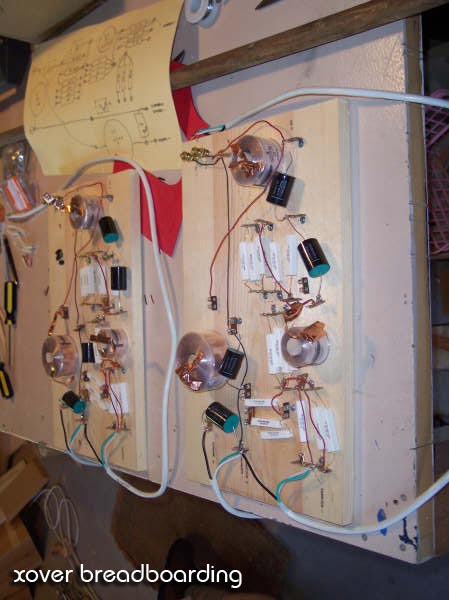 |
|||||||||||||||||||||
 |
|||||||||||||||||||||
About the stuffing: We found that stuffing is a good way to deal with effects in the bass region. We started with about 1.5" of Dacron batting on the inside top, sides, rear and the bottom half of the front panel. No batting on the bottom panel, however. In Stephæn's room, we felt there was a bit of a bump in the response around 40Hz. We reasoned that if this was a box effect, the highest velocities would be away from the end wall so we added a horizontal layer of Dacron batting about 2" thick right at mid height of the enclosure, dividing the enclosure into an upper region and a lower region with the batting layer between. This did seem to reduce the perceived bump, eliminating its masking effects and allowing us to better hear the frequencies much below 40Hz. Note: once the stands arrived in early November, allowing the speakers to be easily repositioned in the room and adjusted for height above the floor, the horizontal layer of stuffing was removed permanently. In the room we have measured response down into the twenties. I'm not absolutely confident of our measurements but we can hear that the speakers play very low frequencies generally very well. |
|||||||||||||||||||||
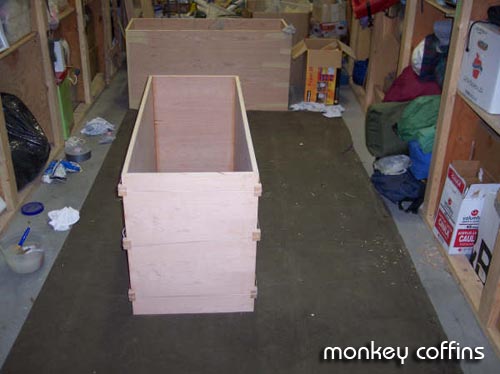 |
The history of the company we now know as the Altec Lansing Corporation goes back to the World War I era. You can read all about that, and much more, at Todd White's impressive and informative website. By the way, here's a few choice comments from Todd about the drivers used in this project: "The 604-8H-II is a redesign of the 604, taking it back to what it was, yet making it better in several ways ... they sound better than the later Ks, better than the early Ks, and at least as good as the Hs. In my opinion -- and I've listened to a lot of 604s in my life -- they sound better than any of the previous models." Todd White | ||||||||||||||||||||
About the vents Our vents' physical length is just the thickness of the wood, which is 3/4". This is the vent length we had input to the Martin J. King worksheet. Our calculations showed nice results for a 6" Ø vent. We used two 5" diameter vents in the bottom of the box. This gave us 39% more vent area than we would have from a single 6" hole. We planned to use Stephæn's Dial-a-Hole to reduce the opening to the preferred area. I was aware when the calculations were made that Vance Dickason thinks the effective length of the vent is the actual length plus 1.46 times the radius. This takes into account the fact that because air outside both ends of the vent moves with air in the vent, one must increase its inertial effect beyond just the mass within the vent (the added mass is called virtual mass). But I was also unsure whether Martin J. King had included a correction factor for vent length in his program. I am kind of doubting he did but did not contact him to find out. It takes a lot of time to do exacting work. Also, there were some words from Jeff Markwart that dismissed the idea the vent length correction could be as great as the correction suggested by Dickason. So I did not add Dickason's correction to the input for our calculations. For our five-inch holes fully opened using Mr. Dickason's correction, the effective vent length would be expected to be .75 inches plus 1.46 x 3 inches, for a total effective length of 5.13 inches. So if Mr. Dickason is correct, the effective length of our vent is very much greater than the physical length. So much so in fact that the physical length is only 1/7th the effective length. One can see that if there is a lot of uncertainty about the true effective length, the experimental results regarding effects of the vent could be a lot different from the calculated results. The system seems to work best in Stephæn's room with both vents wide open. Who knows if it would work better yet with an even larger area? |
|||||||||||||||||||||
| At first we had the bottom of the speaker 4 inches from the floor, putting the center of the driver 39 inches off the floor. We thought the speakers were a little bass heavy there and raised them about two inches further off the floor, then about four inches further. This brought the bass into pretty nice balance. Even after two weeks of 24 hours per day of break-in, we originally found the horn section of the driver to be a little shouty when we first played the speaker - wonderful but a little shouty. Raising the driver two to four inches -- corresponding to an additional one or two degrees off axis -- substantially tamed the shoutiness, not completely but substantially. |
|||||||||||||||||||||
 |
|||||||||||||||||||||
| Regarding the crossover Pretty early on, we added another two ohms of resistance to the three ohms just ahead of the high-frequency output on the crossover board to address the shoutiness originally experienced. This knocks the tweeter down by about 2dB and helps a little but does not completely eliminate the shoutiness. It is typical of the crossovers recommended by Great Plains Audio and Jeff Markwart to include a midrange control section that somewhat attenuates the sound pressure level at a shelf occupying frequencies between maybe 1500Hz and 3300Hz. There is an L-pad associated with this midrange control section to raise or lower the shelf. This midrange control section includes two four-ohm resistors in series with the tweeter branch. A six microfarad capacitor bypasses this pair of four-ohm resistors primarily above 3300Hz. Since the tweeter begins its operation at about 1500Hz, the pair of four-ohm resistors attenuates the tweeter primarily between 1500Hz and 3300Hz, by about 4 to 5dB. We began playing with the value of the capacitor and found that the higher the value, the less shouty the speaker became. Eventually we just bypassed the capacitor with a wire altogether and liked the result. Effectively we were removing the 4-5dB attenuation in the 1500 to 3000Hz octave to get more output in this range. The perceived effect of bypassing the six microfarad midband control capacitor with a wire was two-fold:
|
|||||||||||||||||||||
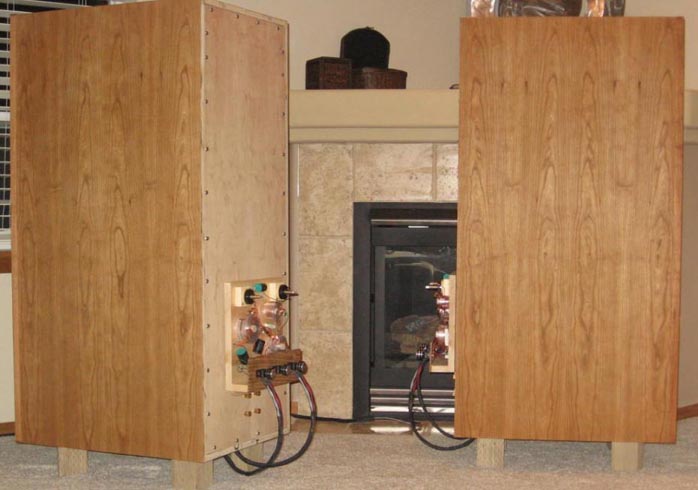 |
|||||||||||||||||||||
With the brilliant and invaluable help of Greg Monfort (aka GM on AudioAsylum.com), I have put together a pretty large MLTL (10.3 cu ft) using the Great Plains Audio 604-8H-II (identical to the Iconic 704). I have now listened to two variations of this MLTL speaker with different porting solutions and baffle widths and to these ears, the sonics of both versions are extraordinary. The speaker has amazing clarity and bandwidth with all the focus and soundstaging capabilities of a single driver speaker. The speaker provides a much bigger, fleshier sound than any single driver speaker I have heard. It works beautifully with 2 or 3-watt SET amps but will take much more power if you care to use it. Since I cannot fit my fantasy 3-way horn rig into my living room, this is an ideal solution. I will live with this speaker a |
|||||||||||||||||||||
| long time to come. - Jay Fischer | |||||||||||||||||||||
 |
How the 604 Dream speakers sound now At this point, Stephæn's 604 Dream project is sounding very mellow, I'd say more mellow than many HiFi oriented folks would choose at least until they became housebroken. But the result is the classic Stephæn-esque result that always happen when you turn him loose with a system - very musical, very laid back, very much "its about the music, not about hifi"... very much the longer you listen the better it sounds and the harder it is to go home and get a good night's sleep. How the 604 Dream 604 speakers look now |
||||||||||||||||||||
| My goodness, they are beautiful! We ended up with a natural Watco oil finish that brings out the grain in the cherry in a most marvelous way. We'll send images but we need to get the stands completed. Stephæn has commissioned a pair, which |
|||||||||||||||||||||
may be something like a simple pedestal on a simple base all in flat black. Should look gorgeous. Don't want to send images until the stands are complete, then we can do glamour photos. How do I feel about it? Proud to have been a part of it. We have done some really nice work. What's next? We are going to do some more messing with the crossover to see what else we can discover. Jay, thanks for your major contributions to our effort. Indeed. Thank you Jay Fisher. And may God and Goddess bless Pete! He was a gutsy man to offer to help me accomplish this project and I would never have blamed him had he chosen to opt out at some point. The results represent many hours of work and as you might imagine, there are still things to be finalized with respect to the crossover. As you can see, I haven't commented on the sound myself. Here's why: It has been remarked that if one selects his own components, builds his own enclosure and is convinced he has made a wise choice of design, then his own loudspeaker sounds better to him than does anyone else's loudspeaker. In this case, the frequency response of the loudspeaker seems to play only a minor part in forming a person's opinion. -L.L. Beranek, Acoustics [McGraw-Hill, New York, 1954], p.208. |
|||||||||||||||||||||
 |
|||||||||||||||||||||
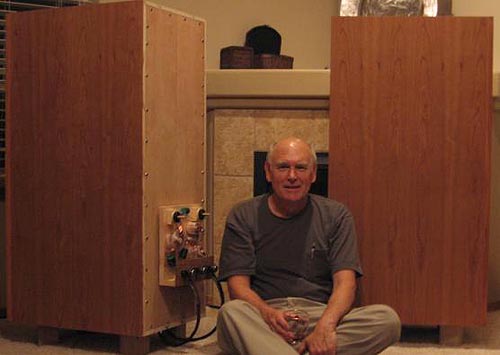 |
|||||||||||||||||||||
| While we did the objective measurements to a good deal of satisfaction, suffice it say that if I'm a victim of Beranek's Law, I'm an exceptionally willing victim who is now held captive by the mirage unfolding in his room every night. For now, all | |||||||||||||||||||||
|
other in-house speakers have been relegated to the second system. Yeah, it took a year from infatuation to fulfillment but it truly was, in the final analysis, worth every second. Better still, my friendship with Pete deepened dramatically as did my understanding -- thanks to him, yet again -- of the art and science of speaker building. So, for me, the notion that we bring into our lives that to which we give our attention does remain a bona fide conviction. |
|||||||||||||||||||||
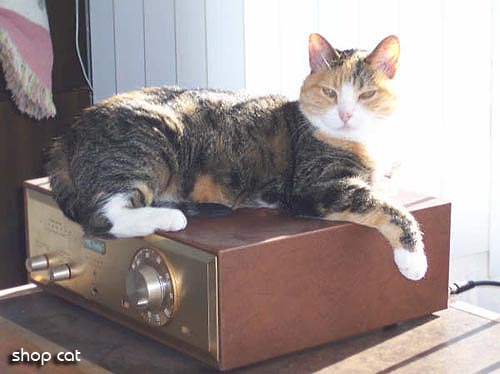 |
|||||||||||||||||||||
 |
|||||||||||||||||||||
 |
|||||||||||||||||||||
 |
|||||||||||||||||||||